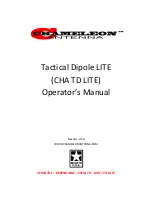
CHA TD LITE
Page 6
Plate 2
.
Matching Transformer, Side View (top), Bottom View (left) and Top View (right).
Antenna Configurations
Using the supplied components, the CHA TD LITE can be deployed into a number of configurations. Five
configurations, see table (2), are described in this manual, each with unique performance characteristics. The
table can assist the operator to quickly select the most appropriate antenna configuration to meet their
operational requirements.
Configuration
Ground Short Medium Long Directionality
Deployment
Sloping “V”
↕
↑
Bidirectional
Deliberate
Horizontal Dipole
↓
↕
↑
Bidirectional
Deliberate
Sloping Wire
↓
↕
Omnidirectional Hasty
Inverted “L”
↓
↓
Unidirectional
Hasty
Horizontal NVIS
↓
↑
Omnidirectional Hasty
Table 2. Antenna Configuration Selection.
To use the table, decide which distance column (Ground = 0 to 90 miles, Short = 0 - 300 miles, Medium = 300
–
1500 miles, Long > 1500 miles) best matches the distance to the station with whom you need to communicate.
Then, determine if the OWF is in the l
ower (↓ = 1.8 –
10 MHz) or upper (↑ = 10 –
30 MHz) frequency range.
Finally, select the CHA TD LITE configuration with the corresponding symbol in the appropriate distance column.
All CHA TD LITE configurations provide some capability in each distance category, so depending upon the
complexity of your communications network, you may need to select the best overall configuration. The
directionality column indicates the directionality characteristic of the antenna configuration. When using NVIS, all
the configurations are omnidirectional.
“Hasty” and “Deliberate” in the deployment column indicate the relative




































